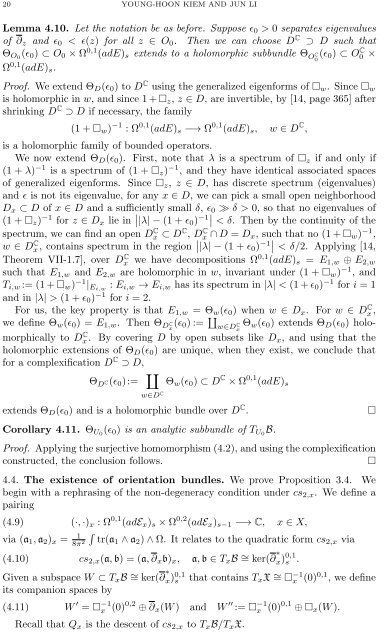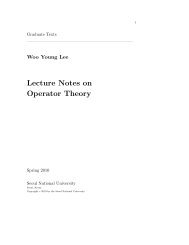Categorification of Donaldson-Thomas invariants via perverse ...
Categorification of Donaldson-Thomas invariants via perverse ...
Categorification of Donaldson-Thomas invariants via perverse ...
Create successful ePaper yourself
Turn your PDF publications into a flip-book with our unique Google optimized e-Paper software.
20 YOUNG-HOON KIEM AND JUN LILemma 4.10. Let the notation be as before. Suppose ɛ 0 > 0 separates eigenvalues<strong>of</strong> ∂ z and ɛ 0 < ɛ(z) for all z ∈ O 0 . Then we can choose D C ⊃ D such thatΘ O0 (ɛ 0 ) ⊂ O 0 × Ω 0,1 (adE) s extends to a holomorphic subbundle Θ O C0(ɛ 0 ) ⊂ O C 0 ×Ω 0,1 (adE) s .Pro<strong>of</strong>. We extend Θ D (ɛ 0 ) to D C using the generalized eigenforms <strong>of</strong> □ w . Since □ wis holomorphic in w, and since 1 + □ z , z ∈ D, are invertible, by [14, page 365] aftershrinking D C ⊃ D if necessary, the family(1 + □ w ) −1 : Ω 0,1 (adE) s −→ Ω 0,1 (adE) s , w ∈ D C ,is a holomorphic family <strong>of</strong> bounded operators.We now extend Θ D (ɛ 0 ). First, note that λ is a spectrum <strong>of</strong> □ z if and only if(1 + λ) −1 is a spectrum <strong>of</strong> (1 + □ z ) −1 , and they have identical associated spaces<strong>of</strong> generalized eigenforms. Since □ z , z ∈ D, has discrete spectrum (eigenvalues)and ɛ is not its eigenvalue, for any x ∈ D, we can pick a small open neighborhoodD x ⊂ D <strong>of</strong> x ∈ D and a sufficiently small δ, ɛ 0 ≫ δ > 0, so that no eigenvalues <strong>of</strong>(1 + □ z ) −1 for z ∈ D x lie in ∣ ∣|λ| − (1 + ɛ 0 ) −1∣ ∣ < δ. Then by the continuity <strong>of</strong> thespectrum, we can find an open D C x ⊂ D C , D C x ∩ D = D x , such that no (1 + □ w ) −1 ,w ∈ D C x , contains spectrum in the region ∣ ∣|λ| − (1 + ɛ 0 ) −1∣ ∣ < δ/2. Applying [14,Theorem VII-1.7], over D C x we have decompositions Ω 0,1 (adE) s = E 1,w ⊕ E 2,wsuch that E 1,w and E 2,w are holomorphic in w, invariant under (1 + □ w ) −1 , andT i,w := (1 + □ w ) −1 | Ei,w : E i,w → E i,w has its spectrum in |λ| < (1 + ɛ 0 ) −1 for i = 1and in |λ| > (1 + ɛ 0 ) −1 for i = 2.For us, the key property is that E 1,w = Θ w (ɛ 0 ) when w ∈ D x . For w ∈ D C x ,we define Θ w (ɛ 0 ) = E 1,w . Then Θ D C x(ɛ 0 ) := ∐ w∈D C x Θ w(ɛ 0 ) extends Θ D (ɛ 0 ) holomorphicallyto D C x . By covering D by open subsets like D x , and using that theholomorphic extensions <strong>of</strong> Θ D (ɛ 0 ) are unique, when they exist, we conclude thatfor a complexification D C ⊃ D,Θ D C(ɛ 0 ):= ∐w∈D C Θ w (ɛ 0 ) ⊂ D C × Ω 0,1 (adE) sextends Θ D (ɛ 0 ) and is a holomorphic bundle over D C .Corollary 4.11. Θ U0 (ɛ 0 ) is an analytic subbundle <strong>of</strong> T U0 B.Pro<strong>of</strong>. Applying the surjective homomorphism (4.2), and using the complexificationconstructed, the conclusion follows.□4.4. The existence <strong>of</strong> orientation bundles. We prove Proposition 3.4. Webegin with a rephrasing <strong>of</strong> the non-degeneracy condition under cs 2,x . We define apairing(4.9) (·, ·) x : Ω 0,1 (adE x ) s × Ω 0,2 (adE x ) s−1 −→ C, x ∈ X,<strong>via</strong> (a 1 , a 2 ) x = 18π 2 ∫tr(a1 ∧ a 2 ) ∧ Ω. It relates to the quadratic form cs 2,x <strong>via</strong>(4.10) cs 2,x (a, b) = (a, ∂ x b) x , a, b ∈ T x B ∼ = ker(∂ ∗ x) 0,1s .Given a subspace W ⊂ T x B ∼ = ker(∂ ∗ x) 0,1sits companion spaces bythat contains T x X ∼ = □ −1x (0) 0,1 , we define(4.11) W ′ = □ −1x (0) 0,2 ⊕ ∂ x (W ) and W ′′ := □ −1x (0) 0,1 ⊕ □ x (W ).Recall that Q x is the descent <strong>of</strong> cs 2,x to T x B/T x X.□













